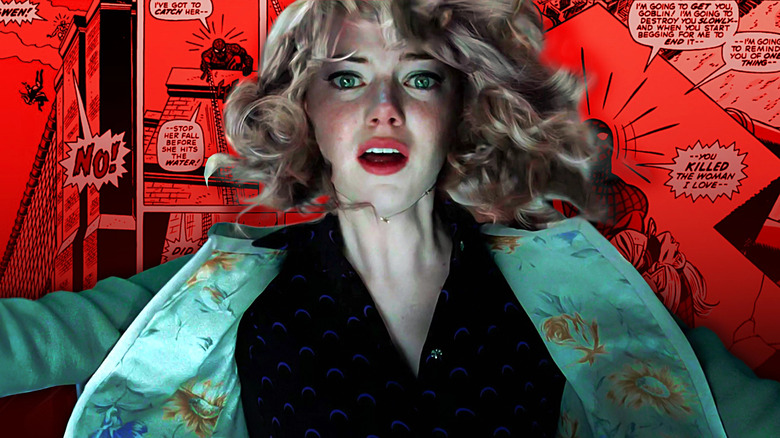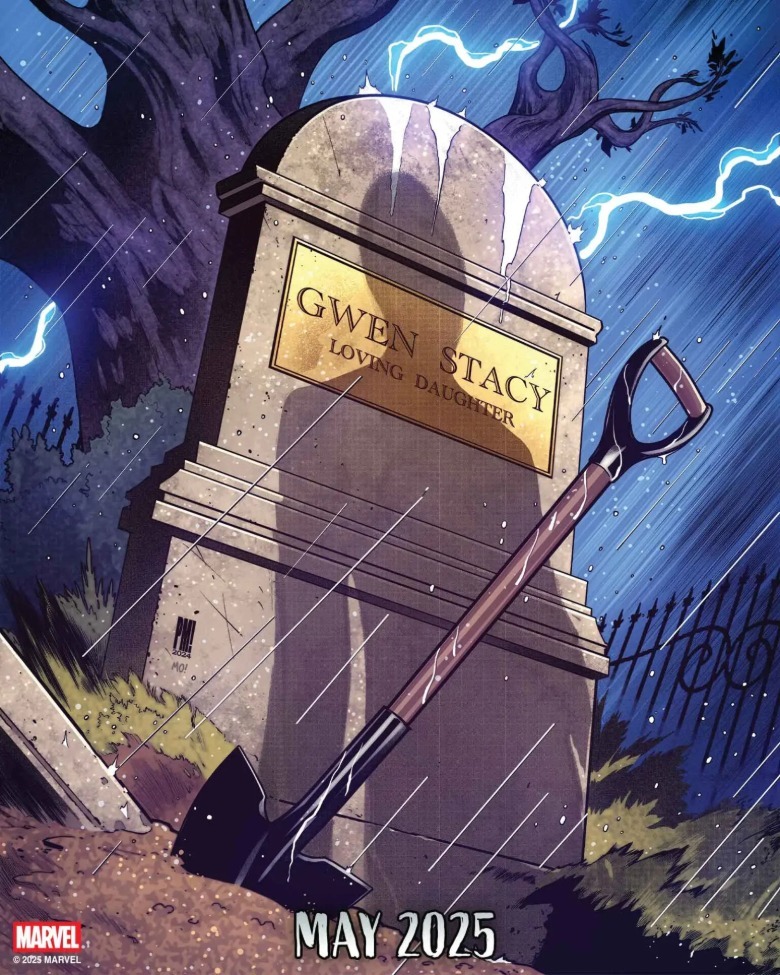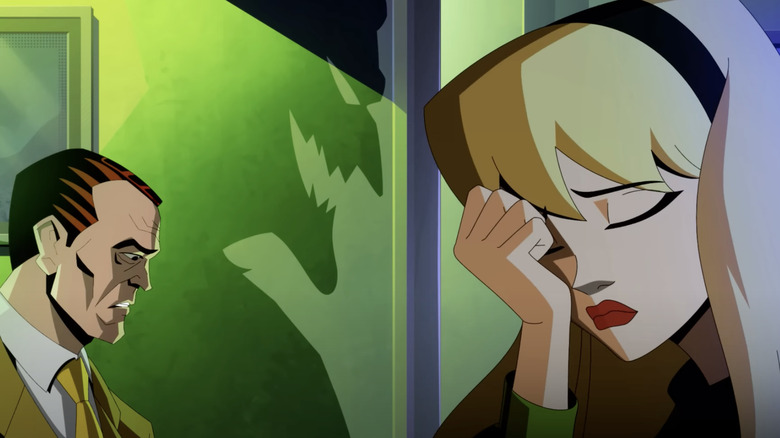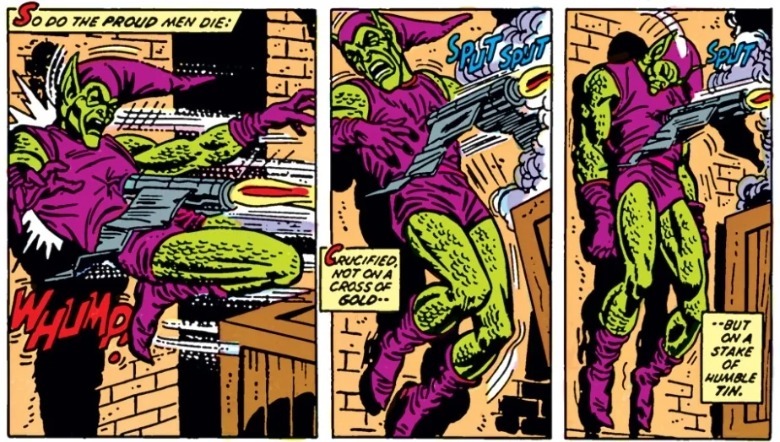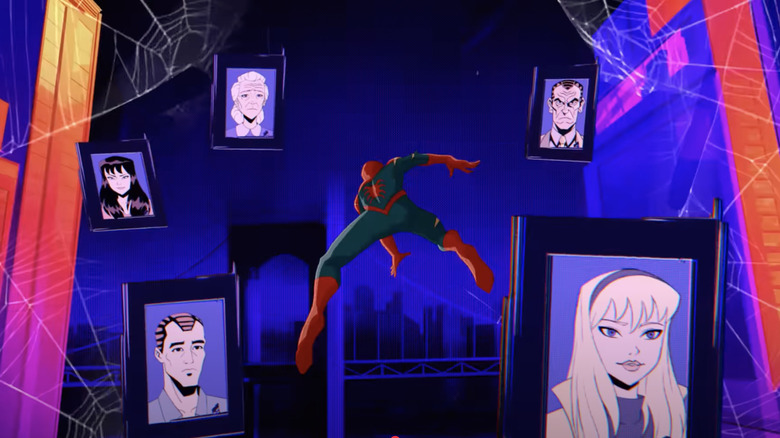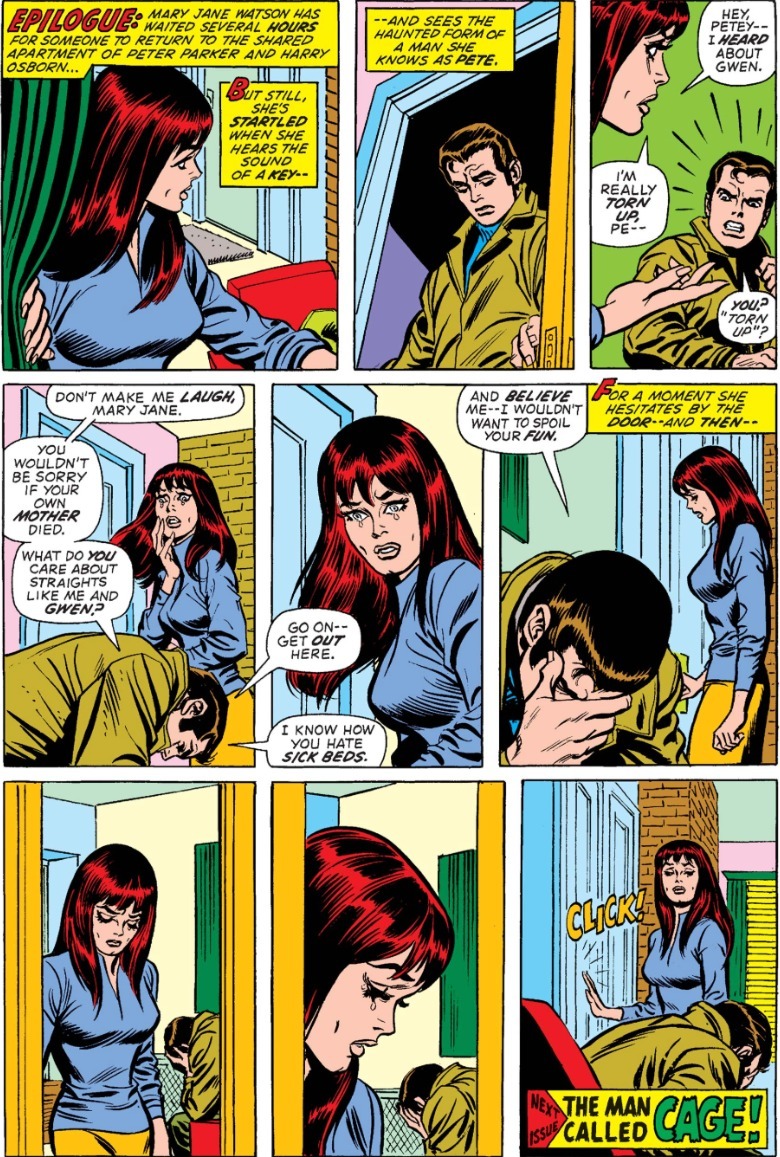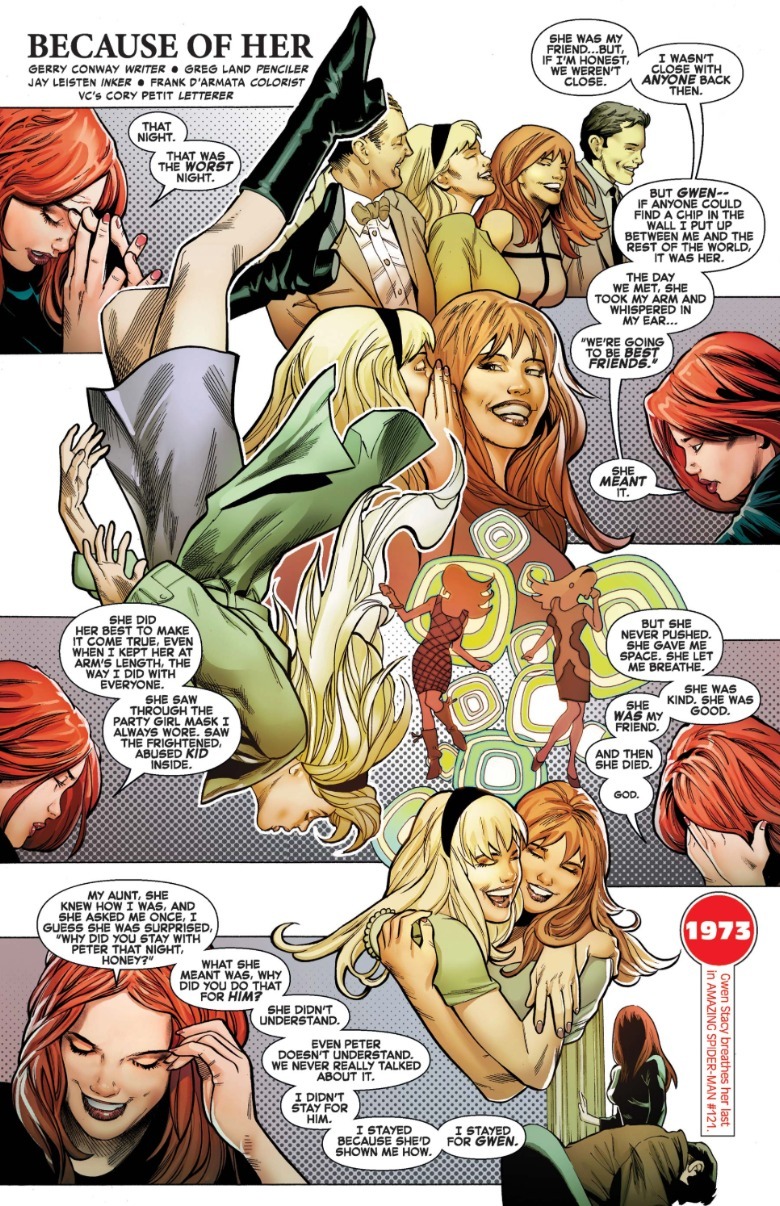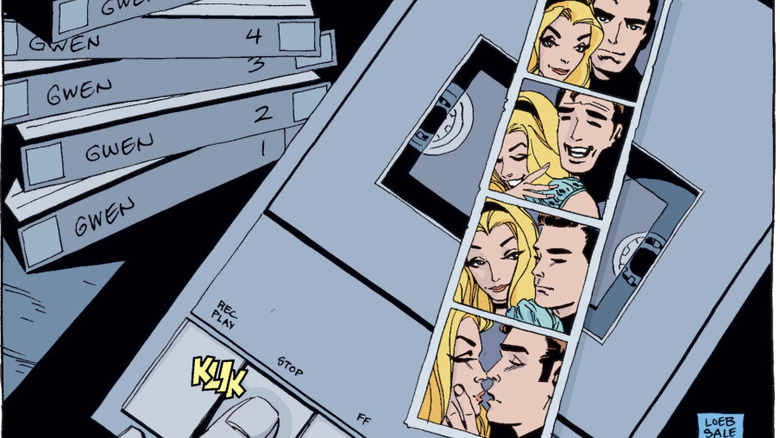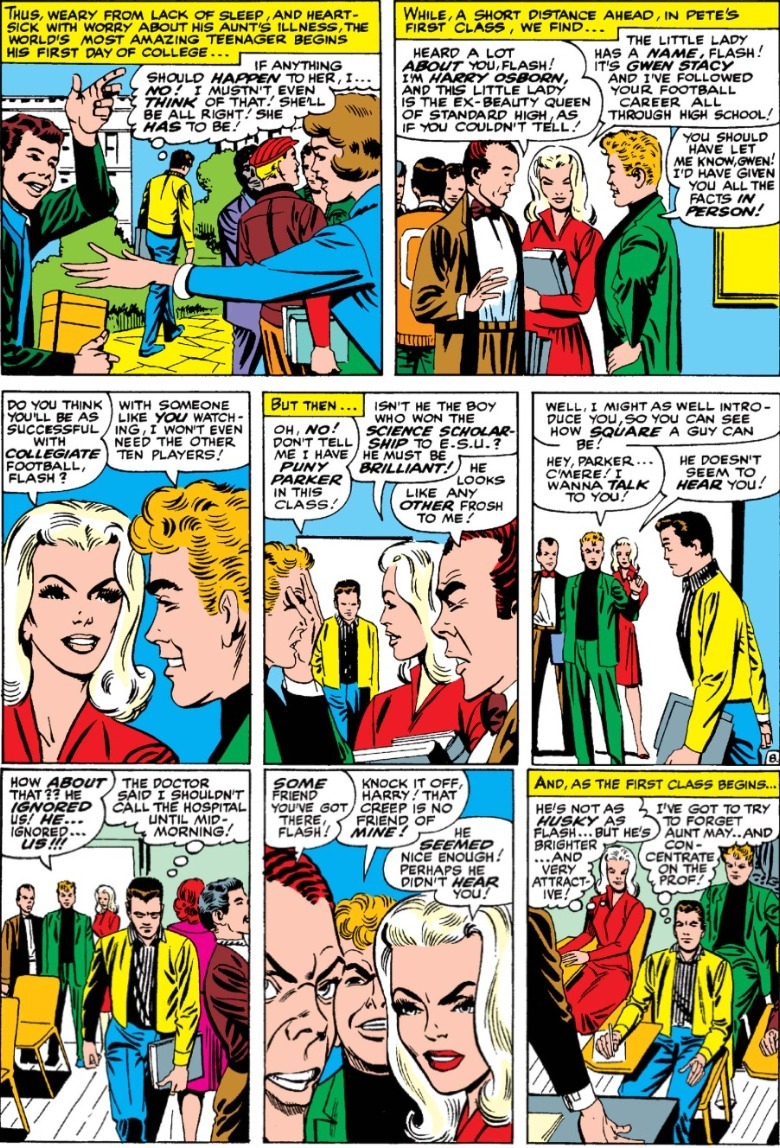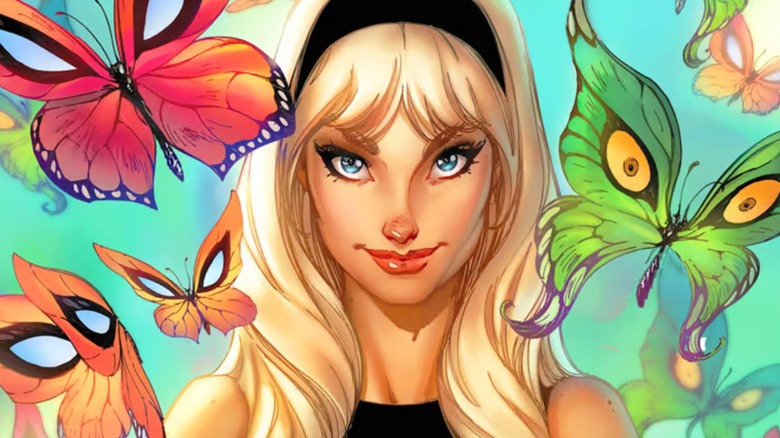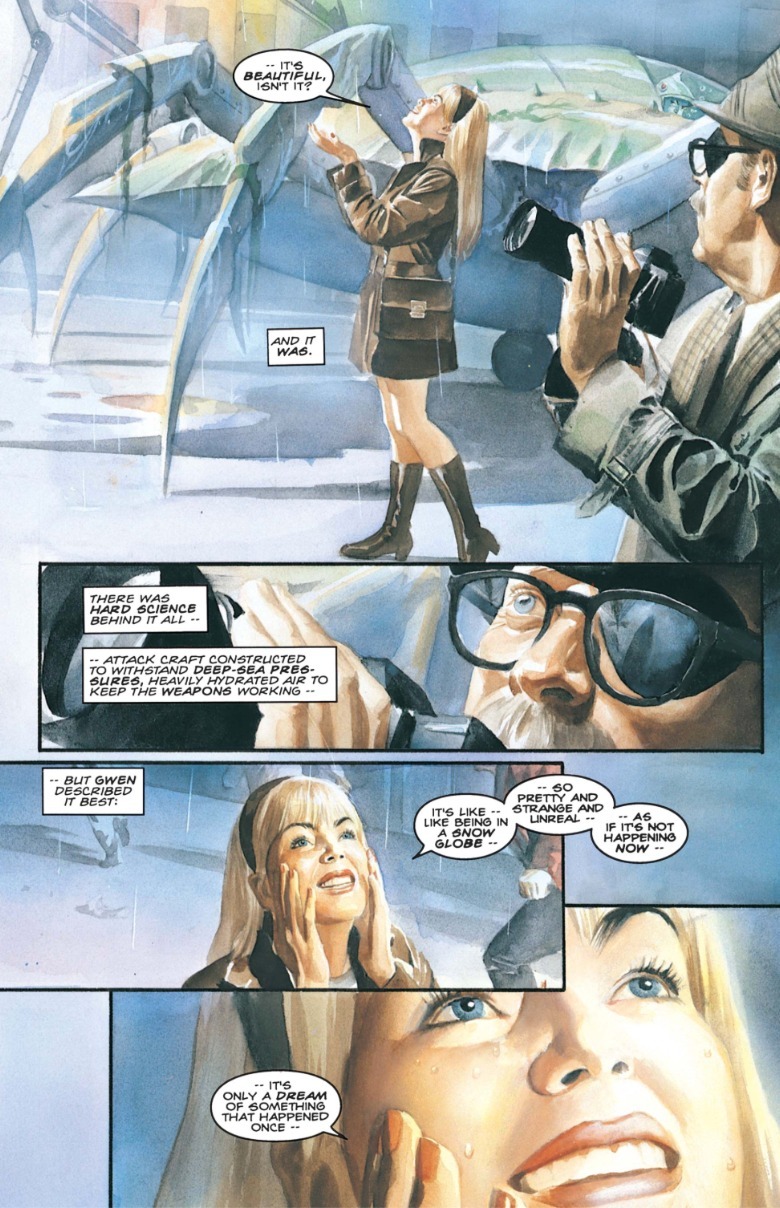Why Gwen Stacy Died In Marvel's Spider-Man Comics, Explained
We may receive a commission on purchases made from links.
It's been said that everyone dies twice: the second is when someone says your name for the last time. Gwen Stacy has never died that second death. Since "The Night Gwen Stacy Died" ran in "The Amazing Spider-Man" issues #121-122 back in 1973, Marvel will not let Peter Parker (or their readers) forget about his lost love, taken from him by Norman Osborn/The Green Goblin.
For the recent 52nd anniversary of Gwen's murder, Marvel shared an animated short (produced by Wild Comet Media and Apus Studio) re-enacting the story:
Jeff Trammell, creator of "Your Friendly Neighborhood Spider-Man," has also confirmed that Gwen will be coming in the show's in-production second season. That news has Spidey fans tingling with excitement. What doesn't is the news that Marvel apparently plans to resurrect Gwen Stacy.
We'll see if this sticks, but Marvel has been digging up Gwen's grave for a long time. The death of Gwen Stacy has been retold literally and in-spirit over and over. It was adapted in "The Amazing Spider-Man 2," when Peter (Andrew Garfield) fails to save Gwen (Emma Stone). When Garfield's Peter returned in "Spider-Man: No Way Home," his arc was all about redeeming himself for that failure.
Many other Spider-Man stories feature him having to save his girlfriend as they fall from great heights. The 1994 "Spider-Man" cartoon, Sam Raimi's "Spider-Man," and Brian Michael Bendis & Mark Bagley's "Ultimate Spider-Man" all swapped in Mary Jane Watson as the one who the Goblin throws off the George Washington Bridge (unlike Gwen, MJ survives).
Gwen's death is one of the most formative moments in Spider-Man's story. Like Uncle Ben's demise, Peter didn't just lose someone he loved, his actions unintentionally killed them. With cornerstone stories like this, it's easy to forget they weren't always there. For almost 100 issues of "Amazing Spider-Man," Gwen was part of the book's ensemble and nothing said her doom was carved in stone. Why did Marvel editorial decide to kill her off? Gerry Conway, who wrote "The Night Gwen Stacy Died," thought Gwen's character and her romance with Peter was a dead end.
Gwen Stacy's death killed many birds with one stone
In "The 100 Greatest Marvels of All-Time" comic series (reprinting the 100 stories that made the list), "The Amazing Spider-Man" #121 came in at #6. A foreword from writer Robert Greenberger recounts how Conway justified the story to him:
"[Gwen] and Peter are terrific together and make each other happy. But that's not what Spider-Man is about. It's about pain and power and the responsibility that comes with it. There's nowhere to take the relationship without betraying what Spider-Man is all about."
At the tail-end of Stan Lee's time on "Amazing Spider-Man," both Peter and Gwen mention marriage in passing, treating their engagement as inevitable. That would've made Spider-Man, who was a hit because he resonated with young readers, too old and happy for Marvel editorial. Conway has also maintained that the story's point wasn't just that Peter Parker must suffer, but that he gets back up from failure and heartbreak. That quality is what makes him a true hero.
Making the Goblin do the deed, for which he himself had to die in issue #122, was also a master stroke. Osborn had learned Peter Parker's secret identity back in "Amazing Spider-Man" #39. That made for a great story, but it risked rocking the boat too much. Stan Lee gave Osborn on-and-off amnesia to spare Spider-Man the moral dilemma of killing his best friend's father and keep the Goblin benched.
But by "The Amazing Spider-Man" #96-98, when Norman regained and then again lost his memory, credibility was beyond stretched. "The Night Gwen Stacy Died" resolved the issue of the Goblin knowing Peter's secret identity once and for all with a climactic final showdown.
Gwen Stacy's death would have the biggest impact on Peter Parker
Historical consensus is that John Romita Sr. — the "Spider-Man" artist who had heated up Peter and Gwen's romance — suggested killing Gwen off.
In a 2015 interview with CBR, Romita cited his inspiration as cartoonist Milton Caniff, who would occasionally kill important characters in his comic strips like "Terry and the Pirates." That's something Marvel's superhero comics didn't (and still rarely) do, and Romita wanted to bring some of that shock factor to "Spider-Man."
Gerry Conway has told the story differently over the years. "Marvel Comics: The Untold Story" by Sean Howe claims that Conway and Marvel editor Roy Thomas had been discussing killing Aunt May, and then Romita stepped in and suggested Gwen instead. In 2019 during an interview with Syfy, Conway claimed the opposite: that Romita first suggested killing Aunt May, and he countered by suggesting Gwen. (Considering these are decades-later recollections, I think it's fair to chalk the inconsistencies up to hazy memories instead of any malicious misrepresentation of credit.)
In the end, both Romita and Conway agreed it had to be Gwen who died. Killing Aunt May wouldn't be surprising enough and it would remove a lot of Peter's hang-ups about his secret identity. Mary Jane Watson was an "airheaded comedy character," as Romita put it, and not even Peter's girlfriend. Her dying wouldn't have the same punch that Gwen's murder would. Their argument swayed Thomas and publisher Stan Lee.
Even if the idea to kill Gwen Stacy wasn't originally his, Gerry Conway wrote the hell out of the story (and Gil Kane drew it just as well). To Conway, Gwen "brought nothing to the mix" and there was much more compelling love interest for Peter: Mary Jane.
But not all fans saw it that way at the time. Conway has attested that he got a lot of angry mail for killing Gwen, and even that he stayed clear of conventions for a time. Stan Lee downplayed his role in the story, claiming he'd been away on (or leaving for) a business trip when the decision to kill Gwen came down. Lee also told The Comics Journal in 1978 that he'd hated the decision to kill Gwen. For what it's worth, Romita backed up Lee's claim in 2015:
"Stan was out of the country when we did that. He accused us of doing it behind his back and he wanted us to bring her back. Roy Thomas and I and everybody else in the company said, 'We can't do that. It would be an embarrassing silliness to bring her back.' We talked him into it, but he was very upset."
Conway's run on "Amazing Spider-Man" came full-circle with "The Clone Saga," where villain the Jackal creates a clone of Gwen. The whole story feels like a backdoor to reviving Gwen, but in the end (issue #149) the clone packed up and left New York. Spider-Man, and his readers, had moved on.
Gerry Conway thought Mary Jane was the girl for Peter Parker... and he was right
From "Amazing Spider-Man" #15 onward, there was a running gag of Aunt May trying to set up a disinterested Peter with "nice girl" Mary Jane, the niece of May's best friend Anna Watson. That all paid off in "Amazing Spider-Man" #42 (drawn by Romita). Finally unable to weasel out of a date, Peter opens the door to meet Mary Jane, and she leaves both he and the reader stunned. MJ had more than looks going for her too.
Lots of MJ's dialogue is now-corny '60s slang, but that's what made her unlike any other character in the book. She was confident, hip, and all-herself. In issue #43, when she and Peter properly get to know each other, she reveals she already has her own apartment and determination to be an actress, whereas Peter still lives with May. When the Rhino tears up Midtown, MJ rides with Peter on his motorbike to see the action.
That led to a brief love triangle in the vein of Archie, Betty, and Veronica, except this one lasted nowhere near as long. Peter was transfixed by Gwen and thought MJ was frivolous. MJ took that on the chin and dated Harry Osborn instead. While she kept flirting with Peter and sometimes cat-fought with Gwen, you could tell it was all fun for her.
While Aunt May fretted over Peter and Gwen was "a non-entity, a pretty face," Mary Jane was the only woman in "The Amazing Spider-Man" who acted like she was the star of her own story. Getting rid of Gwen in favor of MJ was inevitable, Conway claimed when interviewed by Howe:
"The amazing thing was that [Stan Lee] created a character like Mary Jane Watson, who was probably the most interesting female character in comics, and he never used her to the extent that he could have. Instead of Peter Parker's girlfriend, he made her Peter Parker's best friend's girlfriend. Which is so wrong, and so stupid, and such a waste."
The epilogue of "The Amazing Spider-Man" #122 features MJ coming to Peter's apartment. A still-grieving Peter angrily tells her to leave — but she refuses.
As the foundation of Peter and MJ's relationship was their shared grief over Gwen, it's become easy to still dismiss MJ as second in Peter's heart to Gwen. But Conway, too, has rectified that. In his 1989 graphic novel, "Spider-Man: Parallel Lives," Conway showed how MJ had always known Peter was Spider-Man. Gwen never knew or loved the whole Peter Parker, but MJ did. In 2019 special issue "Marvel Comics" #1000, Conway also got to revisit that pivotal epilogue with a one-page story about MJ and Gwen's friendship.
Making Mary Jane into the main woman in Peter Parker's life was 100% the right call. But is Conway's assessment of Gwen accurate? What made Gwen Stacy less interesting?
What Gwen Stacy was actually like in classic Spider-Man comics
When "The Amazing Spider-Man" #31 introduced Gwen, she was set-up as "The Ex-Beauty Queen of Standard High," who hangs out with Flash Thompson and sits atop the social pyramid. She's the kind of girl who would've laughed at Peter before he got his spider powers and a confidence boost with them.
Early Gwen is a tsundere — she thinks Peter Parker is stuck-up but also likes him because he's the only man who doesn't seem to notice her.
But once Peter and Gwen actually started dating, the book pruned all of Gwen's thorns. She got flattened ever further when "The Amazing Spider-Man" #56 introduced her father, police captain George Stacy. From there, she became mostly a soft daddy's girl and a one-dimensional love interest. She was hopelessly in love with Peter, always worrying about him but also pouting when he unintentionally spurned her.
There was dramatic potential for Gwen, but it went untapped. Her father died in "The Amazing Spider-Man" #90 saving a child from Doc Ock, and Gwen blamed Spider-Man. That put Peter in a bind, now that Gwen both loved and unknowingly hated him. The one mistake with killing Gwen off was that she didn't learn Peter's secret identity beforehand.
She'd sometimes show a more flawed side, like supporting "law and order" District Attorney candidate Sam Bullit after her father's death, or snapping at Aunt May for treating Peter like a child. But she mostly fell back into being the good girl, and the drama in her and Peter's relationship was repetitive miscommunication.
Jeph Loeb and Tim Sale's 2002 "Spider-Man: Blue," about Peter remembering how he and Gwen fell in love, also cuts out her early cattiness. It makes sense for that story — Peter is looking back with nostalgia at someone he can never remember objectively. But that's how Marvel writers have remembered Gwen too.
The 2020 "Gwen Stacy" mini-series (by Christos Gage and Todd Nauck) is a prequel about her high school life before she met Peter. But this Gwen matches up with her later characterization, not the original one; she's plucky and close to her dad, running for student body president instead of prom queen. Tellingly, while the book's purpose is to define Gwen's character outside of her romance with Peter, Adam Hughes' cover for issue #1 still depicts Gwen in the outfit she died in.
Marvel has canonized Gwen Stacy as an angel
It's been said that "The Green Goblin ended the Silver Age of Comics" when he killed Gwen. Killing a major character upended the rules of superhero comics, and pushed writers to pen darker stories in the 1970s and 1980s (the "Bronze Age of Comics").
"Marvels," a 1994 mini-series by Kurt Busiek and Alex Ross, follows Daily Bugle photographer Phil Sheldon documenting the rise of Marvelous superheroes up to the 1970s. Gwen becomes a supporting character in issue #4, when Sheldon meets her to interview her about her father's death. Sheldon is mesmerized by her kindness and optimism, and crushed when she's murdered.
Busiek and Ross mark "The Night Gwen Stacy Died" as the moment superhero comics lost their innocence, and make it so Gwen herself personified that innocence.
Sheldon loses his fascination with superheroes because Spider-Man failed to save Gwen, likely echoing how the story shook young readers at the time. Some of those young readers, who grew up to be writers, also took the wrong lesson of trying to recapture the story's impact. Gwen's death inspired the sexist trend of "fridging," where a villain would kill a hero's love interest to hurt them.
Gwen's biggest story being her death means she's also remembered mostly as the girl who died. The 1994 "Spider-Man" series left Gwen out of its supporting cast, feeling they couldn't kill her off in a kids show, and went right to Mary Jane as Peter's love interest. Some are so taken with the tragedy of Gwen Stacy that they latch onto Gwen as Peter's true great love, and a pure soul she was never written as.
Joss Whedon, creator of "Buffy the Vampire Slayer" and director of "The Avengers," once said that Gwen Stacy is "the bedrock of the Marvel universe" (via Buzzfeed News) but was she? To me, that statement borders on revisionist history.
The controversial "Spider-Man: Sins Past" story concludes when Peter remembers Gwen and says "I love you." Cut to present, where MJ is holding him and says "I know," as if she and the comic are admitting she can never compete with Gwen. To rebut that attitude, I'll cite some words Whedon wrote during "Astonishing X-Men." Emma Frost, frustrated that her boyfriend Cyclops is still hung up on his late wife Jean Grey, laments the absurdity that "I still rate below a corpse."
Too many Spider-Man fans and Marvel writers are in love with romanticizing Gwen's tragic life and Peter's lovelorn regrets. That suggests the best relationship is one where a woman is not a real person, just an ideal memory who can never challenge or contradict her man. Peter and Mary Jane's relationship is messier and imperfect but all the more real for it, because "messy" is what a marriage will always be. Why are Peter and Mary Jane broken up in the comics right now? Because the realness of their love and committment to each other gets in the way of the escapism of Spider-Man for the writers and editors who prefer Gwen.
Gwen Stacy: Punk, scientist, superhero?
Since Gwen is remembered for dying, later "Spider-Man" stories that use her tend to be flexible about reinterpreting her. It often feels like writers are trying to correct an injustice, and give Gwen a personality beyond "innocent and doomed girlfriend."
In "Ultimate Spider-Man," Gwen is introduced in issue #14 as a hothead punk. She gets suspended from school when pulling a knife to defend Peter from bullies. This Peter and Gwen stay (mostly) platonic, swapping her and MJ's classic roles: "Ultimate" MJ is the girl next door, "Ultimate" Gwen is the spicy competition Peter turns down. "Ultimate" Gwen also gets to learn Peter's secret identity and get catharsis for her father's death. When "Ultimate" Gwen died at Carnage's hands, it felt rote. This Gwen had become more than what her name suggested, so unlike the classic version, "Ultimate" Gwen got to come back.
Classic Gwen was also described as a science major. Before they started dating, Gwen mostly appeared in her and Peter's college chemistry class. So it's a huge waste that she and Peter rarely bonded over their shared passion. Some later "Spider-Man" stories have taken this trait and made Gwen into more of a nerd, the kind her Lee-Ditko self would've bullied. In "Spectacular Spider-Man," Gwen has glasses, unflattering clothes, and messy hair. Emma Stone's Gwen in "The Amazing Spider-Man" movies looks the part of a beauty queen, but she's an even better scientist than Peter is. In "The Amazing Spider-Man 2," she helps him defeat Electro (Jamie Foxx) with her brains.
Then there's the now-famous "Spider-Gwen," where Gwen herself is a web-slinging superhero. The character was intended as just a supporting bit in the 2014 "Spider-Verse" comic crossover, but her star rose fast, especially after appearing in 2018 film "Spider-Man: Into The Spider-Verse."
Spider-Gwen (voiced by Hailee Steinfeld in the movies) takes a fair bit after Ultimate Gwen; she's got a rebellious edge and is literally a punk rocker, jamming as a drummer in the band The Mary Janes. Turning the original woman in a refrigerator into a hero herself has done a lot to redeem Gwen Stacy's image.
That says it all. Gwen Stacy's potential is fuller than ever, but it's time to stop iterating on her death.
